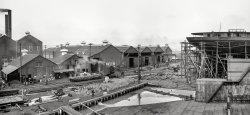
MAY CONTAIN NUTS

Search Shorpy
SHORPY ART

Framed or unframed, desk size to sofa size, printed by us in Arizona and Alabama since 2007. Explore now.
Join and Share
Ad-Free Shorpy
Shorpy is funded by you. Patreon contributors get an ad-free experience.
Learn more.

Recent comments
- Heckuva remote control!
- Sometimes — Things Go Bump!
- I SEE THE LIGHT
- Union Switch and Signal Company
- Get That Light Out Of My Eyes
- Eggs. Eggs. Eggs. The Egg Man is Here!
- Foreboding caption
- Famous Hollywood faces
- Not just S&P
- re: Those things in the jar
- Up In Smoke
- Medical Smoking
- Quick fix
- A Quink Comment
- If You’re Like Me, Never
- Delivering the News
- U.S.A.
- S&P
- 1940 Zenith radio model 6G601
- Quality goes in before the name goes on!
- Snazzy skirt
- Carbon Arc Lamps
- Illuminate us
- I remember it well
- I can't prove it
- Complicated then, forgotten now
- Bryan-Stevenson
- Skinny is as skinny does
- How do you rest in peace
- Riding the footboards
Member Photos
The Shorpy
Print Emporium
Print Emporium
Search Shorpy
Search results -- 30 results per page
- Vesuvius Amoco: 1956
- ... -tterrace]
(Cars, Trucks, Buses, Gas Stations, Railroads) ... Posted by Dave - 10/17/2013 - 2:33pm -
![Vesuvius Amoco: 1956 Vesuvius, Virginia, 1956. "Sometimes the electricity fails." Gelatin silver print by Ogle Winston Link, pioneer of the photographic genre that might be called rail noir. Library of Congress Prints & Photographs Division. View full size.
4-8-2 MountainThe locomotive is a 4-8-2 K2a Mountain—one of twelve (road numbers 126 - 137) built in 1923 by Baldwin for the Norfolk & Western Railway. Its cylinders were 28 x 30 inches, it had 69-inch drivers, a 200 psi boiler pressure, weighed 359,460 pounds, with 57,950 lbs of tractive effort. In this picture #131 is pulling the #2 passenger train northbound on the Shenandoah Division of the N&W.
When these (and ten others built in 1919 by ALCO—road numbers 116 - 125) were rebuilt, they were up-dated with 70-inch drivers, semi-streamlining, boiler pressure bumped up to 220 psi, and an increased tractive effort of 62,832 lbs.
No Norfolk & Western 4-8-2 Mountains survive.
Someone please,Identify that streamlined steam locomotive #131, which to a railfan is the highlight of the photo.
Been there, done thatIn 2012 I went on an odyssey through central Virginia, searching for the locations of Winston Link's photographs, to see whether they could even be found, and if they could, what changes sixty years had made (I found an astonishingly high number, and some hadn't changed as much as you would think). While I found the general store at Vesuvius still standing albeit boarded up, the pumps are gone--the 1923 pump now stands in the Winston Link Museum in Roanoke.
America the BourgeoisWhen all the cool kids drove full-sized Buicks!
The Buickwas O. Winston Link's own car. It also appears in another of his famous photos, along with perhaps the same couple.
There is a fine Link museum housed in the former Roanoke, Norfolk & Western passenger station. In addition to his photos, it also includes his recordings of steam trains and a collection of railroadiana.
As a bonus, the station was redesigned after WWII by Raymond Loewy, and there is a gallery of his work as well.
Great coffee table book!I was given a great photo book of O Winston Link's nighttime rail photos. Spectacular! His use of flash in these black and white photos was great.
[He used floodlights. - Dave]
LightingAccording to wikipedia,
"Link's vision required him to develop new techniques for flash photography of such large subjects. For instance, the movie theater image Hotshot Eastbound (Iaeger, West Virginia), photographed on August 2, 1956 [negative NW1103], used 42 #2 flashbulbs and one #0 fired simultaneously."
While he may have used floodlights he certainly used flash too.
InterestingI was 6 years old then and of course remember the kind of pump behind the attendant being typical through the 50's and 60's. I didn't realize the old 30's era pumps, like the one being used, still being around that late.
More info on Winston LinkActually Link used flashes exclusively in the project, at least for the night shots. He was an engineering major in college, and after graduation became a commercial photographer. He used that background when making and planning his photos, and you can see many of the diagrams made in the planning of the individual shots both in his books and at the Roanoke museum dedicated to his work on the N&W.
The prints made from his negatives are masterful, with tonal variations to make any devotee of Ansel Adams proud. Although the photo reproduction in the books is excellent, nothing beats seeing original Link prints.
OWLish flashLink's night pictures were flash photography: there's a well-known photo of him and an assistant surrounded by some of his apparatus, including one reflector which held eighteen flashbulbs.
Link also did some daytime photography along a branch line which did not operate at night. I have the fortune to own a print from this group, unfortunately a little damaged, which an office mate happened to find for me many years back in a junk shop. Much less dramatic than his night shots, though.
The most famous N&W streamliner, 4-8-4 Class J #611, survives, and there is a campaign being mounted to put her back into excursion service.
1952 SuperDesignated by the three faux portholes on the front fender where a Roadmaster would sport four. The Special also had three, but was built on the smaller body shared by Oldsmobiles. This car would be left in the dust in '53 when its Fireball Straight Eight was replaced by the brand new 322 V-8 in the same chassis.
Still in useThere's a resort on the way in to Kings Canyon National Park that has two functional gravity gas pumps. I had my tank topped off from one them last June.
No Electricity NeededPerhaps I am stating the obvious, but some people may not know how the gas pump in the photo works. The attendant hand pumps the needed amount of gas with the long lever as shown in the photo. The clear cylinder on the top of the pump shows the quantity of gas pumped. Gravity did the rest when filling up the car, thus no electricity needed.
O W L BuickCorrect. It is his car. Fitted with a piece of plywood in lieu of the rear seat to allow more camera equipment to be loaded into the vee-hickle.
The clubFollowing Shorpy feels a bit like belonging to a discussion club.
Whatever the subject of these wonderful photos, there is an audience of enthusiastic, knowledgable members who explain what we are looking at while filling in the sort of fascinating detail that draws you into even the most unlikely subjects. I can't tell you how many times I have clicked off across the web to further investigate a subject after having my appetite whetted by Shorpy and his many followers.
Thanks for both preserving and presenting such evocative photos as well as moderating possibly the most entertaining, educational and civil comments section on the web.
Re: Gravity PumpsI know I'm missing something, but why do the (visible) numbers count the direction they do? It would seem more logical to have 0 at the bottom, so you directly see how many gallons have been pumped into the reservoir.
[The glass cylinder was completely refilled after each sale to be ready for the next customer. See this. -tterrace]
After gravity jars, portholesI remember in the early 60's there were quite a few gas pumps with a small round window on the face. A spinner inside it would indicate flow as your tank was being filled. At least I assumed it was actual gas flowing through it. Could have been just a gadget giving the appearance of that.
Now I suspect it was intended as a transitional gimmick to satisfy the old timers who were used to watching the glass jar empty.
[That was called a sight glass. This report from 1939 to the National Bureau of Standards reports that those un used at the time did not work as purported. -tterrace]
(Cars, Trucks, Buses, Gas Stations, Railroads)](https://www.shorpy.com/files/images/SHORPY_3c37046u.thumbnail.jpg)
- Superior Scales: 1941
- ... View full size.
(The Gallery, John Vachon, Mining, Railroads) ... Posted by Dave - 03/11/2020 - 3:12pm -
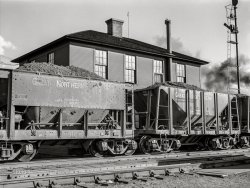
- Enosburg Falls: 1941
- ... Rail Trail.
(The Gallery, Gas Stations, Jack Delano, Railroads, Small Towns) ... Posted by Dave - 01/31/2019 - 9:58pm -
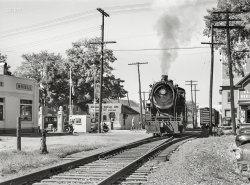
- A Hot Mess: 1901
- ... the building.
(The Gallery, DPC, Glazier Stove Works, Railroads) ... Posted by Dave - 09/23/2014 - 12:38pm -
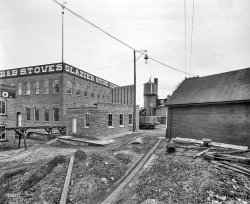
- Bridge Out: 1865
- ... in '65.
(The Gallery, Boats & Bridges, Civil War, Railroads, Richmond) ... Posted by Dave - 07/31/2013 - 1:24pm -
![Bridge Out: 1865 April 1865. "Richmond, Va. Ruins of Richmond & Petersburg Railroad bridge." Span over the James River, burned by Confederate troops before the advancing Federal Army. Wet plate negative by Alexander Gardner. View full size.
Remains of the supports left of route 60.View Larger Map
The Rail Linehere is the Richmond & Petersburg. The brick structure the left is presumably the burned-out paper mill; to the right and behind the photographer was the railroad depot. This is less than a half-mile from the (then and now) State Capitol, but a bit farther because of the need to find a bridge across the James River and Kanawha Canal, that passed between.
Well builtWell built, main arterial bridge support, I'm surprised it was never rebuilt for rail use.
The Great ConflagrationLooking at this one gets an idea of the mayhem and terror of a city in its death throes. Put this image with the many others taken of the industrial district and put them alongside those of Berlin or Dresden in 1945 and you can barely tell them apart. Although the occupation of Richmond was nowhere near as bad as was expected, the night the Confederate Army abandoned it held as much confusion and fear as any city in history left to hordes of invaders. Besides the columns of troops marching out, the streets were filled with half starved women and children looting government storehouses, unemployed prostitutes (at least temporarily), street urchins, deserters and gangs of released prisoners from the penitentiary stealing from everybody and drinking from the street gutters the whiskey poured out by the provost guards. During all this, munitions dumps were exploding and raining shrapnel all over the place. Several accounts from soldiers leaving the city recall the sight of the burning city and one described it as being "at once, both terrible and sublime". Another compared it to Dante's Inferno. By the grace of God, the yankee "hordes" were not as bad as feared and order was quickly brought to the city. But we have to remember that on that night, the citizens and soldiers (many of whom left loved ones behind) didn't know that. They didn't know that a day later Lincoln would tell the general commanding the occupying troops to "...let them up easy, General, let them up easy."
A Couple near the riverDid anyone else notice the couple sitting near the river (approximately 25 feet or so) to the left of the burned out bridge?
[Looks like three people. -tterrace.]
Re: A Couple Near the RiverIt's very possible that they are paroled Confederate soldiers wondering how to get across so they can go home. Or they could be displaced workers from one of the mills or the Armory. There were a lot of people and soldiers from other parts of the state and other states as well as foreigners cast adrift in Richmond in '65.
(The Gallery, Boats & Bridges, Civil War, Railroads, Richmond)](https://www.shorpy.com/files/images/SHORPY_02892a_0.thumbnail.jpg)
- Infinite West: 1941
- ... Larger Map
(The Gallery, Landscapes, M.P. Wolcott, Railroads) ... Posted by Dave - 02/12/2015 - 9:48am -
![Infinite West: 1941 September 1941. "Buena Vista, Colorado (vicinity). The Sawatch mountains." Medium format negative by Marion Post Wolcott. View full size.
VistaSuch a view is why we need the word: "vista".
Yet, even this vastness has been conquered three ways: the railroad tracks, the telegraph lines, and the barbed-wire fences on both sides on the rail line.
What do you suppose was the photographer's vantage point -- a water tower, perhaps?
[Her car window. - Dave]
Western entropy:
The posting by Shorpyite, "swaool", gives us today's view of this vista; showing the deterioration of the conquering elements: an abandoned rail line, vanished telegraph lines, and the infamous barbed wire fences, installed in such straight lines are gone or lost in the weeds.
Even the vantage point, a highway bridge, is in an aged condition.
But Nature survives.
Vantage PointTo me it is quite easy to discern. The photo was taken from the right side forward looking window of a train engine.
[Yes, if your locomotive is 40 feet tall and you are waaay above the top of the telephone poles. Below, an actual cab view. - Dave]
IMHOThe vantage point can't be her car window unless her car window is higher than those power lines.
[What a puzzler. Maybe she chartered a balloon. - Dave]
lol. But I see that others have cleared it up by pointing out that she was on a bridge. I should have thought of that lol.
BYOONA-vistaThat's how they pronounce it there -- "byoonie" for short.
Through the Rockies, not around them This is the route of the Denver and Rio Grande Western Railroad from Pueblo to Dotsero, Colorado. Built to compete with the Union Pacific, it was downgraded after a more direct route was built from Denver to Dotsero though the long Moffat Tunnel and on to Salt Lake City. Being duplicative and containing some significantly steep grades it has been out of service since 1997.
Part of the line includes the scenic Royal Gorge, seen elsewhere on Shorpy.
The SubI guess Jack Delano was somewhere else that day.
SpellingWouldn't that be Wasatch?
[Too bad you don't have the Internet. - Dave]
Vantage PointShe was most likely on the US 24 highway overpass about a mile south of Buena Vista. The view is to the SSE, and the railroad is the former Denver and Rio Grande Western's original mainline via Tennessee Pass, no longer used by present owner Union Pacific.
[The 1937 bridge Ms. Wolcott was on was scheduled for replacement in 2014, but is still in this Street View image from 2012. -tterrace]
View Larger Map
(The Gallery, Landscapes, M.P. Wolcott, Railroads)](https://www.shorpy.com/files/images/SHORPY-8c31857a.thumbnail.jpg)
- Meanwhile, Back in Petoskey: 1900
- ... but "cowcather": never!
(The Gallery, DPC, Petoskey, Railroads) ... Posted by Dave - 08/10/2012 - 12:05am -
![Meanwhile, Back in Petoskey: 1900 Petoskey, Michigan, circa 1901. "Grand Rapids & Indiana R.R. station." 8x10 inch dry plate glass negative, Detroit Publishing Company. View full size.
Always a first hereNever have seen a boat on a baggage carrier before.
Engine/TenderI'd like to see that engine and tender from the side; it appears that it's a commuter run (from the crowd on the platform) but it must run in reverse a lot because of the cow-catcher on the tender. No turn wye at either end of its run? Railfans - help?
Typical Trolley StopOk typical turn of the century trolley stop. two trolleys numerous interesting people, wait a second go back the sort of dapper guy in the foreground with the lapstrake skiff on a hand truck. Excuse me buddy but you can't take your fishing boat on the trolley even if you pay 2 fares.
I am really trying to figure this one out and just what is he doing with the boat at a trolley stop, we will probably never know.
[He's taking it (or sending it) somewhere else. This is, as noted in the caption, a railroad station, not a a trolley stop. - Dave]
Sorry Dave I was only looking at the Trolley that was probably bringing people to the train. But on another note, why is there a man sitting in the boat? is he part of the shipment?
Take a ride on the GR&IClick to embiggen.
It's a double enderIn this era about the only locomotives with big headlights on both ends were either switchers or double-enders. The catcher on the rear does indeed indicate this hog has regular assignment on a job where half of the trips are backward.
The earlier picture of Petoskey shows a train ready to leave here, probably with this very engine, running in reverse.
If you search an old GR&I timetable from this time, you'll find out where this train was going. It probably ran to some branch terminal that had no turn facilities, or it may have ended its run at some main line station that had no turn facility.
One of the most famous short line steam roads today, Pennsylvania's Strasburg Rail Road has been doing that from the start; there never have been turn facilities at Strasburg.
Next StopYou are right, the engine is designed to run tender first at the head of the train. The likely destination is Harbor Springs, which was served by a branch line diverging just north of Petoskey. Another depot photo shows a main line train on the track adjacent to the station, and a branch line train with a similar engine, tender first, on the next track. In some eras, through Pullmans were carried from Cincinnati and Chicago, dropping wealthy tourists close to their lake front hotels.
Tank EngineThe loco is a tank engine -- it has no separate tender. Both the coal bunker and water tank are carried on a rearward extension of the loco frame, in this case on a four-wheeled truck. It is a type of engine commonly but not always correctly referred to in the US as a "Forney." They were designed to be run safely at track speed in either direction without turning, making them well suited to suburban trains.
Railroad expansion plansCompare this one to the Petoskey depot view posted a few days earlier. Station platform is longer and has a new roof structure in 1908. New station platform surface. More tracks about the depot -- the expansion process is evident in this picture with rock wall stone on the flat cars. Extra track is to be added and the water spout seems to be missing in '08 shot -- as is the station semaphore signal. Engine number 4 is backing toward you in this view -- and may be the engine in the foreground in the 1908 view -- a number 4 seems to be on the forward headlight number board of the 4-4-0 in the '08 view though it is not clear. The engine cabs are a bit different -- back cab windows are at a higher level in the 'o8 photo. Rolling tail light shade is missing in this shot but evident in the '08 view.
Suburban Station at PetoskeyThis is the GR&I (later PRR) suburban station at Petoskey, which operated during the summer months for tourists headed out for the day at Walloon lake or Alanson. The steam engine pictured could operate in either direction (without turning on a wye track) to facilitate quick turnarounds. This suburban station was located about two blocks to the south from the main passenger station which still exists in 2011, without passenger train service.
"cowcatcher"?? Puleeze!!The proper term used by railroad personnel is "pilot".
The "station semaphore" is properly called "order boards" and the "water spout" was commonly called a "standpipe".
Possibly, in other parts of the world, these other terms may have been different, but "cowcather": never!
(The Gallery, DPC, Petoskey, Railroads)](https://www.shorpy.com/files/images/SHORPY_4a07903a.thumbnail.jpg)
- Rolling on the River: 1908
- ... )
(The Gallery, Boats & Bridges, DPC, Railroads) ... Posted by Dave - 07/22/2016 - 4:38pm -
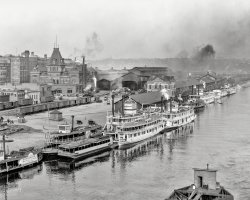
- Snowy Joliet: 1943
- ... the capacity of the scale.
(The Gallery, Jack Delano, Railroads) ... Posted by Dave - 12/24/2014 - 10:50am -
![Snowy Joliet: 1943 March 1943. "Joliet, Illinois. Leaving the Atchison, Topeka & Santa Fe railyard." Photo by Jack Delano for the Office of War Information. View full size.
Can't quite make it outKeep the door closed when ??????????? cars.
[Illegible in the original. -tterrace]
Sign, sign, everywhere a signMy take:
KEEP THIS DOOR
CLOSED WHEN NOT
WEIGHING CARS
Mixed Signals?That looks like a train order signal. Not motorized, each blade appears to be manually operated by means of a pipe that extends down each side of the mast to just above the ground and then... nowhere. No trackside racks for delivering orders/messages on the fly, no telegraph office visible... are there any Santa Fe experts out there who know what this signal might have been for?
WestboundMr. Delano was looking back from the caboose of a westbound train; the view is actually NNE. Des Plaines River/Sanitary and Ship Canal to the left, EJ&E bridge and Joliet Coke Plant in the background.
The Scale HouseAn important ancillary building once found in nearly every yard, but now less common, was the scale house.
Most cars containing bulk commodities such as grain, coal, and such were weighed - both to determine the weight for transportation charges by the railroad, and often for the charges the shipper would bill their customer for the merchandise. Every car had (has) the empty weight of the car stenciled on the side of the car, and the switching crew and a clerk would weigh each car, and subtract the Lt Wt (Light Weight, as stenciled) to determine the weight of the contents, and attach the scale ticket to the Bill of Lading.
Note that there are four rails past the scale house. The Live Rails were for weighing the cars, the Dead Rails (or Bypass Rails) were so that engines could pass the scale without using the Live Rails, since their weight often exceeded the capacity of the scale.
(The Gallery, Jack Delano, Railroads)](https://www.shorpy.com/files/images/SHORPY-8d26313u.thumbnail.jpg)
- Mountain Retreat: 1905
- ... 1905 was within a transition period of several years where railroads handled a mixture of passenger and freight cars that were slowly and ... crossing sraight ahead.
(The Gallery, DPC, Railroads) ... Posted by Dave - 04/12/2016 - 4:22pm -
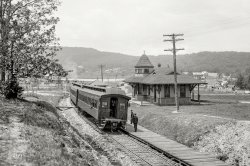
- It's a Small Train: 1951
- ... cool place and neat history.
(LOOK, Los Angeles, Railroads) ... Posted by Dave - 01/07/2015 - 8:00am -
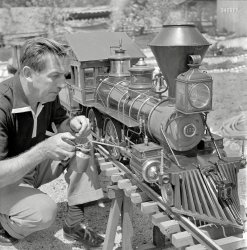
- Lackawanna: 1900
- ... project can be found here .
(The Gallery, DPC, Railroads) ... Posted by Dave - 08/02/2012 - 4:13pm -
![Lackawanna: 1900 New Jersey circa 1900. "On the Lackawanna near Far Hills." With the bridge and little white house seen in the previous post. Detroit Publishing. View full size.
Oddly AngledThe trapezoidal footprint of the bridge probably reflects the engineers' desire for triangular, rather than square, bracing at the ends. Triangles being structurally much stronger than squares. We can also see a height gauge on either side of the tunnel, with hangers that would make a noise to indicate overheight locomotives. Wouldn't have much time to react, though.
Double TracksShould a train derail here, the extra rails (guard rails) will keep the wheels trapped between the running rails and the guard rails and probably saving the bridge from being hit by the train or, worse yet, the train taking out the bridge.
There Goes My Vertigo!I'm surprised no one has mentioned it previously, but do the angles of this bridge appear odd to anyone else? It's nearly enough to set off my vertigo. I'm sure the bridge was specifically engineered for this particular appication, but it almost gives the sense of just being slapped together.
Absolutely fascinating.I love finding the locations of the photos posted on Shorpy's using Google Earth. I could spend hours searching. I love this site.
Mystery SolvedToo cool that you found this photo!
180°You're looking at this RR bridge from the other direction now. The road goes over the stone bridge at the other end, and the stucco house is over on the right, next to the road. And a stream or small river was only hinted at by the RR bridge as viewed in the previous Far Hills view.
To have a look abt. 2006 in Google Earth, here are the coordinates. 40.696909,-74.651628
Main Street changes to Peapack Road as it crosses over the RR tracks. The tracks then cross what's left of the river (Lackawanna?) which can barely be seen in Google maps as it meanders around in the wooded (green) areas. In Maps there is also a train headed up to the bridge from a mile south of the intersection. (Same coordinates, ya know)
But Dave already knew all this, right Dave?
[90°, not 180. The previous view was from the right, along the country lane that passes above the trestle seen here. The trestle is visible to the left in the previous photo. - Dave]
Given the camera angle from "Far Hills 1900" and the angle formed by the road and the RR tracks, the view in Lackawanna 1900 is, really Dave, 180° out. Pull out your protractor, please!
[To recap: This view is perpendicular, more or less, to the previous view. Below, the end of the trestle (circled) closest to the bridge, and the path of the tracks through the two stone arches whose headers bracket the road. - Dave]
Twin TracksI should know this, since my grandfather was a railroad engineer on the IT, but why are there two sets of rails?
Why we come.I not only come here regularly for the cool old photos but the hilarious commentary and analysis are also worth the price of admission.
Now this shot makes me wistfulI grew up on top of a hill about a mile or so to the right of the little white house in the first shot. We could look across the valley (which contained Main Street and the railroad tracks and the "stream", as we called it) at the Kate Macy Ladd Home (later Natirar, now some kind of resort).
The railroad trestle was exactly the same then, and we walked across it many times, always running as fast as we could through the tunnel. lest one of those old Erie-Lackawanna chuggers hit us. Peapack-Gladstone was the end stop on the spur, which had been built out that far to provide a NY connection for the residents of places like the Ladd house and Blairsden.
Years later, one of our large retrievers disappeared. We found him right at the spot in the photo, where he'd been hit by a train.
Like I said -- it makes me wistful. She was a very loving, if rather dumb, dog.
TelltalesThose are telltales hanging over the track to warn anyone riding top of car of upcoming low overhead. The bridge crosses the creek at an angle and therefore the abutments and trusses are staggered.
No CalatravaBut it gets the job done, I suppose.
HogbackThe bridge angles seem strange because this is an example of a skewed truss. As another poster pointed out, a skew is a result of a bridge making a crossing at an angle other than 90°.
This bridge was known as the Hogback Bridge over the Raritan River and was replaced by NJ Transit in 2004 over the span of a single weekend. Its replacement is a non-skewed through truss. More info on the bridge and the replacement project can be found here.
(The Gallery, DPC, Railroads)](https://www.shorpy.com/files/images/4a07231a.thumbnail.jpg)
- Hot Springs Depot: 1900
- ... Company. View full size.
(The Gallery, DPC, Railroads) ... Posted by Dave - 04/11/2018 - 2:14pm -
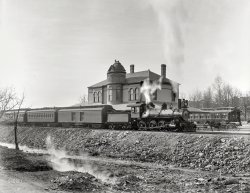
- Auto-Railer: 1935
- ... (The Gallery, Cars, Trucks, Buses, D.C., Harris + Ewing, Railroads) ... Posted by Dave - 05/28/2014 - 7:29am -
![Auto-Railer: 1935 ANNAPOLIS, Md., June 26, 1935 (AP) -- Negotiations have been started by the Evans Products Co. of Detroit for the purchase of the Washington, Baltimore & Annapolis Railway, which was recently sold at auction here. The company manufactures buses and trucks that operate either on rails or on the highway, and it is understood the concern plans to operate 100 passenger and freight units between Washington, Baltimore and Annapolis. ... The "auto railer" consists of front and rear steel pilot railroad wheels attached to a conventional type of bus or truck. The pilot wheels are raised for operation over highways but can be let down when the vehicle reaches the tracks. The vehicle runs on its own tires over the rails with the pilot wheels guiding it along the track.
1935. Washington, D.C., or vicinity. "Streamline Bus and Car, Evans Motor." Harris & Ewing Collection glass negative. View full size.
Are any extant?If so, what a novel and attractive project for a guest house/lake/mountain house conversion.
Let me beYou can stand there all day and have your picture taken, for all I care, but this headlight is really something interesting.
SafetyPresumably you can retract the wheels and drive off the tracks when a real train comes along too.
Washington and Old DominionThe Washington and Old Dominion obtained one of the Evan units from the defunct Arlington and Fairfax and converted it to a maintenance vehicle.
Kickin' the TiresSir, I advise you NOT to kick THAT tire.
Evans Auto-railer in actionI recalled seeing an old clip of this machine in action, and here it is. I believe that the scenes were taken along the Grand Trunk Western Jackson Subdivision which ran from Pontiac to Jackson, MI. The branch was abandoned in 1975.
1935 fashionBroad lapels, rolled up trousers, hats and no belly fat!
[Those are real cuffs. -tterrace]
Not a Bump in a CarloadFairmont Railway Motors (now Harsco Rail) is often given credit for coming up with the road-rail technology that created "hi-railers" (they spell it "HY-RAIL") in the 1940s, but the various versions of the Evans product had already been in production for years. The car-like one below was known as the M2.
Their largest Auto-Railer (below) was only one of over a dozen diverse products they made for the war effort during WWII.
Modern TravelerEveryone has done such a good job on the history of auto-railer that I am left to guess at the signage behind the gentlemen. TRIAL “Modern Traveler” ROAD RAIL COACH BODY? Love the Art Deco font.
[SUPERIOR "Modern Traveler." Also: CHEVROLET CHASSIS, TIMKEN AXLES / GOODRICH & UNITED STATES TIRES. The "Modern Traveler" was a streamlined bus body made by Superior Motor Coach Co. of Lima, Ohio. - Dave]
C-Span connectionEvans Products was founded by John Steptoe Evans, whose grandson John D. Evans was a co-founder of C-Span.
Evans Products started out building wood products; first, a wooden block that allowed easy loading of autos on railcars, then cedar separators for the plates in a car battery. John S. Evans set a record in 1928 by flying around the world in 28 days.
Gramps' good jobI knew my grandfather worked for a company called Evans so I emailed my dad this link. here was his reply:
"Yes, this is the same Evans Products. More than that, your grandpa spent a couple of his years at that time driving one of these for the Company when we lived in Detroit. He would be gone for weeks at a time. First, he worked in a small city, Paris, Illinois, and later was transferred to Washington, DC. It always sounded like a good idea to me. It was equipped with both railway wheels and rubber tires, with a mechanism to lower the rubber tires or raise the railway wheels, so they could use the seldom-used rail lines like street-car tracks. Of course the rail lines fought them and tried to scare the public about potential collisions. In the end, the politicians voted against it ... but your grandpa was part of it."
Alas, he's not in the photo, but what a pleasure to see a glimpse of his world. Thanks, Shorpy!
Gramps' JobThat Washington, D.C. job may have been on the Arlington & Fairfax trolley line, which replaced its electric cars with Evans Autorailers. I think they wanted to drive them across the Potomic River without using the D.C. streetcar tracks. One of those later wound up on the Chicago, South Shore & South Bend RR in 1955, with a platform on the roof for working on the overhead wires in East Chicago, Ind.
(The Gallery, Cars, Trucks, Buses, D.C., Harris + Ewing, Railroads)](https://www.shorpy.com/files/images/SHORPY-39036a.thumbnail.jpg)
- Payday 1906 (Alternate Take)
- ... Company. View full size.
(The Gallery, DPC, Railroads) ... Posted by Dave - 08/21/2012 - 10:50am -
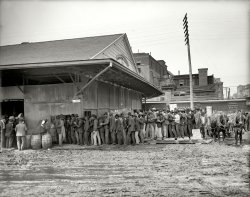
- Mountain House: 1905
- ... glass negative. View full size.
(The Gallery, DPC, Railroads) ... Posted by Dave - 08/25/2017 - 12:51pm -
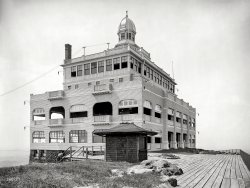
- Mass. Transit: 1912
- ... closes.
(The Gallery, Boats & Bridges, Boston, DPC, Railroads, Streetcars) ... Posted by Dave - 08/15/2012 - 2:39pm -
![Mass. Transit: 1912 Boston circa 1912. "East Cambridge Bridge." A visual compendium of ways to get from here to there. 8x10 glass negative, Detroit Publishing Co. View full size.
Not much has changedThe trolley track viaduct is still there. The building on the left with the tower still exists. It overlooks the Charles River dam. It still has a drawbridge over the connection lock between the river and Boston Harbor. Farther up on the left past the tower is now the location of the Boston Museum of Science.
Beauty lost to timeView Larger Map
Sensational!Remarkably, much of what is depicted in this photograph, which looks from Boston back across the Charles River to Cambridge, remains in place. Most prominently, the poured concrete viaduct for the trolley (today, referred to as the Green Line) running along the right side of the photo, is still there. I have often looked at the "1910" date engraved on the arched pediment above the column at the far right, and wondered what this part of town must have looked like when this structure was new. There is currently a drawbridge in the location where the police officer is standing in the middle of the road, in order to let sail boats get through from the Charles River (to the left) out to the Boston Harbor (to the right). The drawbridge is currently being rebuilt, and this section of road is actually closed for traffic for the next several weeks. The buildings on the left are still there as well. The tower is used (I believe) to control the drawbridge, and the lower building serves as a State Police station. A few weeks ago, a car was passing underneath the archway at the far right of the photograph, and a large chunk of concrete fell from above and shattered the driver's rear windshield. The whole structure still has a wonderful look to it, but it does need some attention.
Bridge over the River CharlesI was surprised to see that the arches of this bridge were originally much narrower than they are today. (Although you can see the 1910 date has been retained.) Trolleys still run on that bridge, although it's now the only section left of a much longer elevated track that was mostly put underground during the Big Dig. There is also a drawbridge on the roadway now for boats to pass through, although it very rarely goes up these days -- mostly only on the Fourth of July when yachts come in from the harbor to watch the fireworks.
The building on the left is now a State Police outpost (perhaps it was then, too.) The Museum of Science now occupies the open space behind it.
Five out of sevenpossible methods of transportation shown here. Steam powered
rail, electric trolley, horse-drawn vehicles, motorized vehicles, and walking! Surprisingly, I couldn't spot anyone on a bicycle, nor could I see any boats in the water.
[Let us not forget the aeroplane. - Dave]
"New" HistoryHow cool it must have been to witness a construction project of this scope knowing that there probably isn't another of its type anywhere nearby. It reminds me of seeing I-75 south of Detroit being built at the end of my street in the mid 1960's where there was never a freeway before.
101 years and still on the moveThe location is in Boston, at the old Charles River Dam, which is visible as an earth rampart at the left, behind the tower with the weathervane. The trolley viaduct is in current use as part of the MBTA Green Line service. At the viaduct's end, you can see the still-existing ramp down across the roadway to Lechmere station.
In the roadway below, currently known as Monsignor O'Brien Highway and Route 28, it looks like they haven't yet installed the Craigie Drawbridge (though they've installed the traffic control gates for the streetcar, the sidewalks look like they're still solid instead of part of a drawbridge). Also interesting is the high drawbridge built into the trolley viaduct, to accommodate sailboats entering the Charles River.
The Metropolitan District Commission building on the left (which now houses state police) has the control tower with the weathervane on top. The viaduct drawbridge is no longer operational (but the ironwork is still there), and the one in the roadway is being rebuilt right now, in a project running November 2010 through April 2011.
The two buildings at the left edge of the photo, just in front of Wellington-Wildwood Coal, are an MDC stable and boathouse. The stable is now used for work trucks by the Dept. of Conservation and Recreation, which is the renamed MDC, and the boathouse at far left is empty and deteriorating. The view of these buildings would now be blocked by the Museum of Science and its garage.
Behind the coal company building and a little to the right is the square tower (with peaked roof) of the Clerk of Courts building in Cambridge, with the main courthouse next door not visible.
Everything to the right of the viaduct is gone and changed, though there's still a major railroad crossing there for traffic to North Station.
The polesThe trolley viaduct opened in June 1912. The draw in the Cragie bridge is there, it is just hard to see. Those poles in the middle of the road are to lift the trolley wire when the bridge opens, and to realign it when span closes.
(The Gallery, Boats & Bridges, Boston, DPC, Railroads, Streetcars)](https://www.shorpy.com/files/images/4a24492a.thumbnail.jpg)
- The Cane Train: 1904
- ... View full size.
(The Gallery, DPC, Havana, Railroads) ... Posted by Dave - 05/24/2017 - 10:41am -
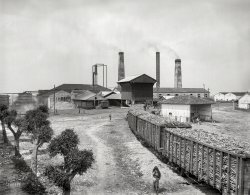
- The Wrong Side: 1938
- ...
(The Gallery, John Vachon, Kids, Omaha, Railroads) ... Posted by Dave - 08/02/2017 - 9:26am -
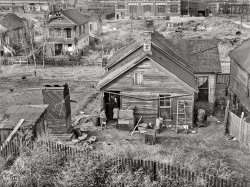
- Southern Pacific blacksmith shop. In Oakland?
- ... View full size.
(ShorpyBlog, Member Gallery, Railroads) ... Posted by bowdidge - 09/20/2011 - 8:22pm -
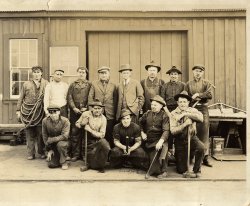
- River City: 1904
- ... full size.
(The Gallery, Boats & Bridges, DPC, NYC, Railroads) ... Posted by Dave - 01/16/2018 - 6:16pm -
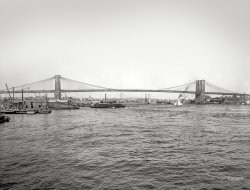
- Heavy Lifting: 1910
- ...
(The Gallery, Boats & Bridges, Cleveland, DPC, Railroads) ... Posted by Dave - 08/01/2014 - 9:05am -
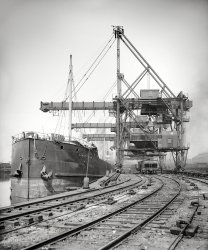
- Winnipesaukee Cannonball: 1906
- ... 4-4-2s from the early 20th century.
(The Gallery, DPC, Railroads) ... Posted by Dave - 05/04/2015 - 10:32am -
![Winnipesaukee Cannonball: 1906 Circa 1906. "Railway station at Weirs -- Lake Winnipesaukee, New Hampshire." 5x7 inch dry plate glass negative, Detroit Publishing Company. View full size.
Still there!The station is still in use, selling tickets for cruises on the lake and for the scenic railroad trips that use these same tracks.
Now with ample parking:
A statue in the street?Is that a statue of a soldier leaning on his rifle directly in front of the speeding buggy, or a gas lamp hanging from the pole in the foreground?
[Looks like a water fountain with provision for horses. A common kind of street furniture of the period, though not always as fancy. -tterrace]
Civil War monumentSpent many happy days at the Weirs as a child. The 19th ct Mt. Washington still plies the lake. The Civil War monument and horse trough was located in front of the NH veterans home in the 1880s and was unfortunately struck by lightning and destroyed in the 30s.
WaterThe name Winnipeg (the city where I was born) comes from both Cree and Ojibwe words for dirty or murky or muddy (wini) and water (nipi). Winnipesaukee is from the Abenaki language and is translated as the Smile of the Great Spirit but also Beautiful Water in a High Place or Good Smooth Water at Outlet. I favor the water option. And I suppose one person's murky is another person's beautiful.
Shorpy's Guide to NH tourist traps continues!First Market Square, now The Weirs. Is Monadnock next?
To clarify a previous post by nhman, the "19th ct" Mt Washington burned in 1939. The current Mt Washington II started life in 1888 on Lake Champlain. They chopped it up, put it on rail cars, and welded it back together at Lakeport to replace the burned out Mt Washington. Still pretty neat.
And now that I'm fact checking it... The train station burned down at the same time. So I'm not so sure Hillary's street view is the same building.
Still there but notThis is not the same building as the original picture. When the Mount burned at the dock the Depot building of that time was lost where the fire consumed the dock leading from the depot. This building that replaced that building was removed some time in the last 20 years.
ID'ing the locomotiveI'm guessing that this is a Boston & Maine class C-17 4-6-0, based on the side view seen partway down this page.
Lovely engine. My favorite locos by far are the high-wheeled passenger 4-6-0s and 4-4-2s from the early 20th century.
(The Gallery, DPC, Railroads)](https://www.shorpy.com/files/images/SHORPY-4a27253a.thumbnail.jpg)
- Diaper Depot: 1942
- ... this image.
(The Gallery, Kids, Marjory Collins, NYC, Railroads) ... Posted by Dave - 04/28/2017 - 10:59am -
![Diaper Depot: 1942 August 1942. "New York, New York. Waiting for trains at Pennsylvania Station." Photo by Marjory Collins for the Office of War Information. View full size.
Old Penn StationAs someone who has to regularly commute through the "new" Penn Station, photos like these of the old, now-destroyed station make me sad. I love the juxtaposition in this photo; the bored commuter, the new mom, the nattily-dressed porter and the escalator riders behind them. Where the floor has worn away in the station, the glass-embedded tiles shown here still show through.
[The "glass-embedded tiles" are skylights of the kind seen on sidewalks above building basements, usually with the glass turned purple from long exposure to sunlight. -tterrace]
Mini-railWhat is the little semi-circular railing on the right for?
What we do for loveYoung parents of today may not realize how hard it was on the backs of parents when they had to change their baby's diaper away from home. The changing tables in many of today's public bathrooms are a great help and relief to parents with back or joint problems and probably are more sanitary for the baby too (as well as random onlookers). I don't think anyone had disposable diapers then either, you had to carry it around with you. This is not one of the things we would like to go back to.
Stairway to HeavenTo ColoZ: The U-shaped cutout in the railing may have been for a ticket-checker to stand in without getting bowled over by the crowds.
ColoZ and Marysd: several of the current staircases down to the platform level have the original banisters and iron work partially visible in this image.
(The Gallery, Kids, Marjory Collins, NYC, Railroads)](https://www.shorpy.com/files/images/SHORPY-8d21795a.thumbnail.jpg)
- Way Station: 1943
- ... Canal Street.
(The Gallery, Chicago, Jack Delano, Railroads) ... Posted by Dave - 03/13/2015 - 10:16am -
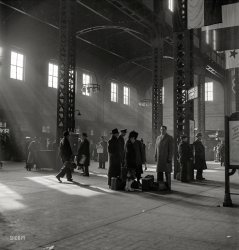
- Götterdämmerung: 1942
- ... of January 2016.
(The Gallery, Chicago, Jack Delano, Railroads) ... Posted by Dave - 07/27/2015 - 12:51pm -
![Götterdämmerung: 1942 December 1942. "Chicago, Illinois. Repair and overhauling in the Chicago & North Western Railroad locomotive shops." Medium-format negative by Jack Delano for the Office of War Information. View full size.
Franklin BoosterLooking in the lower left corner of the photo, the item on the cart is a Franklin Booster. These were mounted usually on the rear truck of larger steam engines and provided extra tractive effort at lower speeds. The SP 4449 has one.
Flooring: bricks or wood blocks?The flooring may be wood blocks set on end, rather than bricks or stone blocks. I've seen this in another roundhouse, the reasons for using wood were (a) absorb oil, rather than providing a very slippery surface for oil spills, (b) less chance of damaging a part if it were dropped.
GötterdämmerungI see what you did there... :)
Twilight of the GodsWhen exactly does the fat lady sing?
Wood blocksDuring the late 1920's and early 1930's my father was the engineer who was in charge of the Brooklyn Bridge. He told me that the bridge was paved with wooden blocks set on end very much like the railroad shop in the picture. . When the blocks became worn they were picked up and turned over. Relatively light weight, non-slippery and durable.
Wrong TitleAlas, Götterdämmerung is an ending. A better title might be: "Nacht und Nebel" or Night and Fog.
[Twilight of the Gods = the fast-approaching final days of the huge steam locomotives which up to this point had ruled the rails unchallenged. -tterrace]
Various AppliancesA poster below already pointed out the booster engine on the closest track. Good call; I had no idea what it was. The cylinders on the floor to the right of the booster are interesting. I want to say that they're compressed air reservoirs, but they appear to be way too long, so I have no idea.
Lead and trailing trucks are being worked on tracks 2 and 3. There's a 2-wheel pony (leading) truck on track two that is flipped over. To the right of that is a 4-wheel trailing truck off a 2-8-4. The trailing truck on track 3 that the guy is welding inside is off an H Class 4-8-4, pictured many times on Shorpy. Neither locomotive is in the picture. Perhaps if we turned the other way? The picture looking the other direction is on here someplace.
Great Delano exhibit in Chicago going on nowJust visited the Jack Delano "Railroaders" exhibit at the Chicago History Museum. The exhibit focuses on the people who insured that America's WWII railroad supply lines ran efficiently and at full capacity. Great photos (black and white AND COLOR!) of dozens of railroaders, from top management down to the gofers. Terrific insights into the dispatching and maintenance of the trains and great stories of the folks and families who depended on railroading as a livelihood. Lots of train photos, too. If you are a fan of Jack Delano's art or a fan of mid-20th century railroading, don't miss this exhibit. It runs through the end of January 2016.
(The Gallery, Chicago, Jack Delano, Railroads)](https://www.shorpy.com/files/images/SHORPY-8d23858a.thumbnail.jpg)
- Instant Message: 1942
- ... home.
(Technology, The Gallery, Chicago, Jack Delano, Railroads) ... Posted by Dave - 04/26/2013 - 11:47am -
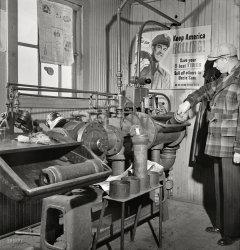
- Elko Depot: 1940
- ... He was a good guy.
(The Gallery, Arthur Rothstein, Railroads, Small Towns) ... Posted by Dave - 02/20/2018 - 11:01am -
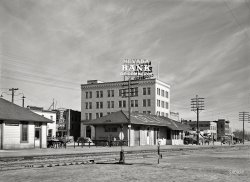
- Kansas Cornucopia: 1941
- ... View full size.
(The Gallery, M.P. Wolcott, Railroads) ... Posted by Dave - 10/14/2019 - 11:57am -
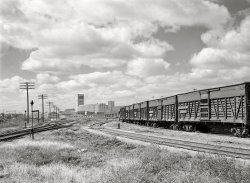
- Fast Fraight: 1906
- ... chemical industry.
(Panoramas, Boats & Bridges, DPC, Railroads) ... Posted by Dave - 08/25/2017 - 10:54am -
